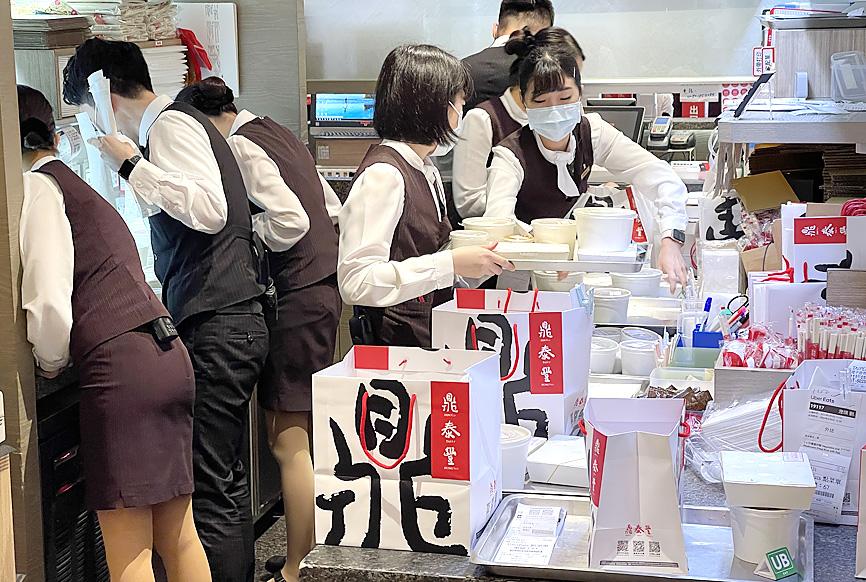Sales generated by the food and beverage industry last month totaled NT$61.9 billion (US$2.07 billion), up 61.7 percent from a year earlier and the second consecutive month of year-on-year growth, the Ministry of Economic Affairs said on Monday.
Huang Wei-jie (黃偉傑), deputy director of the ministry’s Department of Statistics, said that the significant growth was partly the result of a relatively low comparison base in June last year, when on-site dining was not allowed due to a level 3 COVID-19 alert.
Many food and beverage vendors last month intensified efforts to launch promotional campaigns to boost sales, while a gradual decline in domestic COVID-19 cases and an increase in the number of people vaccinated against the disease meant more consumers were willing to dine out, Huang said.

Photo: CNA
Last month, revenue posted by restaurants in Taiwan rose 61.7 percent from a year earlier to NT$51.1 billion, sales generated by beverage shops grew 66.6 percent to NT$8.5 billion, while revenue from catering businesses increased 46.9 percent to NT$2.4 billion, the ministry said.
In the first six months of this year, food and beverage industry sales totaled NT$399 billion, up 10.4 percent from the same period last year, with revenue generated by restaurants, which accounted for about 83.5 percent of the total, hitting NT$333.3 billion, up 9.6 percent from a year earlier, the ministry said.
The growth in sales momentum is expected to continue this month, with sales in the food and beverage industry forecast to be between NT$63.2 billion and NT$64.4 billion, up 48.5 to 51.5 percent from a year earlier, Huang said.
Huang said he remained upbeat about domestic demand in the second half of this year, although rising inflation might curb consumer spending.
Last month, retail sales rose 22.5 percent from a year earlier to NT$326.5 billion, a record for the month, ministry data showed.
In addition to a low comparison base last year, the growth was evidence that more consumers were willing to spend, Huang said.
Sales posted by department stores, convenience stores and hypermarkets rose 173.8 percent, 11.4 percent, and 6 percent respectively from a year earlier to NT$24.2 billion, NT$31.5 billion and NT$19.8 billion last month, the data showed.
Bucking the upturn, revenue generated by supermarkets fell 11.1 percent annually to NT$21.2 billion due to a high comparison base in the same month last year, the ministry said.
Online retailers’ sales totaled NT$33.7 billion last month, up 4 percent from a year earlier, the ministry said.
In the first half of this year, retail sales rose 6.7 percent annually to about NT$2.04 trillion, it said.
Retail sales for this month are expected to range between NT$338.2 billion and NT$347.3 billion, up 11.3 to 14.3 percent from a year earlier, the ministry said.

CHIP RACE: Three years of overbroad export controls drove foreign competitors to pursue their own AI chips, and ‘cost US taxpayers billions of dollars,’ Nvidia said China has figured out the US strategy for allowing it to buy Nvidia Corp’s H200s and is rejecting the artificial intelligence (AI) chip in favor of domestically developed semiconductors, White House AI adviser David Sacks said, citing news reports. US President Donald Trump on Monday said that he would allow shipments of Nvidia’s H200 chips to China, part of an administration effort backed by Sacks to challenge Chinese tech champions such as Huawei Technologies Co (華為) by bringing US competition to their home market. On Friday, Sacks signaled that he was uncertain about whether that approach would work. “They’re rejecting our chips,” Sacks

NATIONAL SECURITY: Intel’s testing of ACM tools despite US government control ‘highlights egregious gaps in US technology protection policies,’ a former official said Chipmaker Intel Corp has tested chipmaking tools this year from a toolmaker with deep roots in China and two overseas units that were targeted by US sanctions, according to two sources with direct knowledge of the matter. Intel, which fended off calls for its CEO’s resignation from US President Donald Trump in August over his alleged ties to China, got the tools from ACM Research Inc, a Fremont, California-based producer of chipmaking equipment. Two of ACM’s units, based in Shanghai and South Korea, were among a number of firms barred last year from receiving US technology over claims they have

It is challenging to build infrastructure in much of Europe. Constrained budgets and polarized politics tend to undermine long-term projects, forcing officials to react to emergencies rather than plan for the future. Not in Austria. Today, the country is to officially open its Koralmbahn tunnel, the 5.9 billion euro (US$6.9 billion) centerpiece of a groundbreaking new railway that will eventually run from Poland’s Baltic coast to the Adriatic Sea, transforming travel within Austria and positioning the Alpine nation at the forefront of logistics in Europe. “It is Austria’s biggest socio-economic experiment in over a century,” said Eric Kirschner, an economist at Graz-based Joanneum

OPTION: Uber said it could provide higher pay for batch trips, if incentives for batching is not removed entirely, as the latter would force it to pass on the costs to consumers Uber Technologies Inc yesterday warned that proposed restrictions on batching orders and minimum wages could prompt a NT$20 delivery fee increase in Taiwan, as lower efficiency would drive up costs. Uber CEO Dara Khosrowshahi made the remarks yesterday during his visit to Taiwan. He is on a multileg trip to the region, which includes stops in South Korea and Japan. His visit coincided the release last month of the Ministry of Labor’s draft bill on the delivery sector, which aims to safeguard delivery workers’ rights and improve their welfare. The ministry set the minimum pay for local food delivery drivers at